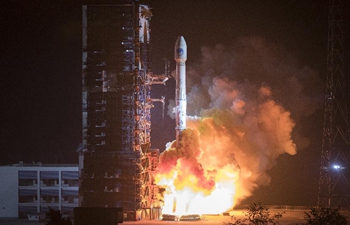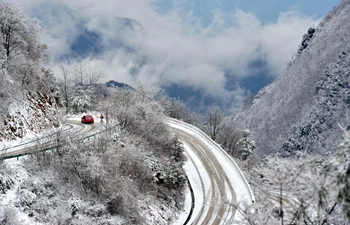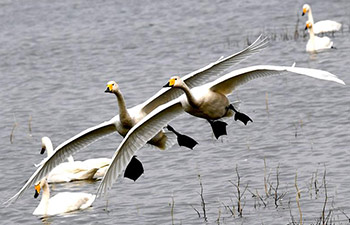WASHINGTON, Nov. 19 (Xinhua) -- The United States space agency NASA on Monday announced a landing site for its upcoming Mars 2020 rover mission, choosing the geologically complicated Jezero Crater as the landing site.
The rover mission is scheduled to launch in July 2020 as NASA's next step in exploration of the Red Planet. It will seek signs of ancient habitable conditions and collect rock and soil samples and store them in a cache on the planet's surface.
NASA and European Space Agency are exploring ways to retrieve the samples to Earth, making the landing site a critical location for Mars exploration in next decade.
Jezero Crater is located on the western edge of a giant impact basin just north of the Martian equator, according to NASA.
"The landing site in Jezero Crater offers geologically rich terrain, with landforms reaching as far back as 3.6 billion years old, that could potentially answer important questions in planetary evolution and astrobiology," said Thomas Zurbuchen, associate administrator for NASA's Science Mission Directorate.
"Getting samples from this unique area will revolutionize how we think about Mars and its ability to harbor life," said Zurbuchen.
The 45-km crater, once home to an ancient river delta, could have collected and preserved ancient organic molecules and other potential signs of microbial life from the water and sediments that flowed into the crater billions of years ago, according to NASA scientists.
However, its geologic diversity with boulders, rocks, cliffs and wind-derived ripples may also cause problems for the rover's landing.
"Nothing has been more difficult in robotic planetary exploration than landing on Mars," said Zurbuchen.
"The Mars community has long coveted the scientific value of sites such as Jezero Crater, and a previous mission contemplated going there, but the challenges with safely landing were considered prohibitive," said Ken Farley, project scientist for Mars 2020 at NASA's Jet Propulsion Laboratory.
"But what was once out of reach is now conceivable, thanks to the 2020 engineering team and advances in Mars entry, descent and landing technologies," said Farley.
NASA's mission engineers refined the landing system so that they reduce the landing zone to an area 50 percent smaller than that for the landing of NASA's Curiosity rover at Gale Crater in 2012.
Also, NASA scientists are developing a new capability called Terrain Relative Navigation that will enable the "sky crane" descent stage, the rocket-powered system that carries the rover down to the surface, to avoid hazardous areas.













